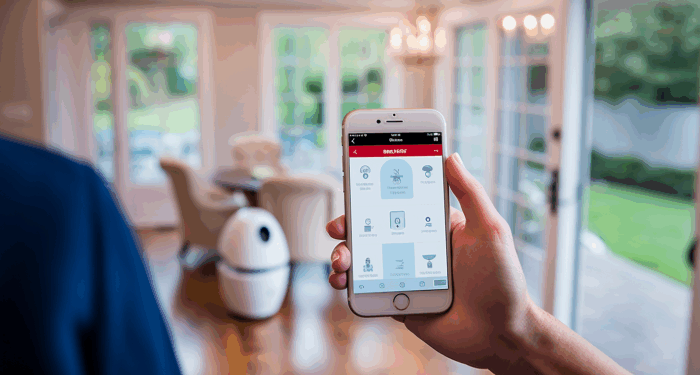In the fast-evolving landscape of modern security, the installation of smart security systems stands out as a crucial element. This opening passage invites readers on a journey filled with insights, offering a blend of expertise and innovation for an enriching read.
Delve into the realm of smart security systems and discover the key aspects that redefine safety and convenience within homes.
.
Importance of Smart Security Systems
Smart security systems play a crucial role in ensuring the safety and security of modern homes. With advancements in technology, these systems offer a range of benefits that go beyond traditional security measures.Advantages of Smart Security Systems
- Remote Monitoring: Smart security systems allow homeowners to monitor their property from anywhere using their smartphones or tablets. This real-time monitoring provides peace of mind and enables quick response to any security issues.
- Integration with Smart Home Devices: Smart security systems can be integrated with other smart home devices such as smart locks, lights, and thermostats. This integration enhances overall home automation and convenience.
- Customizable Alerts: Smart security systems can send customizable alerts to homeowners in case of any suspicious activity or breaches. These instant notifications help in taking immediate action to prevent potential threats.
Enhanced Home Safety and Convenience
- Video Surveillance: Smart security systems offer high-definition video surveillance, allowing homeowners to monitor their property with clarity. This visual evidence can be crucial in identifying intruders or suspicious activities.
- Smart Access Control: With features like keyless entry and remote access control, smart security systems provide convenient ways to manage home entry and grant access to trusted individuals.
- Energy Efficiency: Some smart security systems are equipped with energy-saving features that help in optimizing energy consumption and reducing utility costs, contributing to a more sustainable and eco-friendly home environment.
Types of Smart Security Systems
Smart security systems come in various types to cater to different needs and budgets. Let's explore some of the common options available in the market.1. Camera-based Systems
Camera-based smart security systems are popular for providing visual surveillance of your property. These systems typically include high-definition cameras that can be placed indoors and outdoors to monitor activities in real-time. Some features of camera-based systems include:- 24/7 video monitoring
- Motion detection
- Two-way audio communication
- Cloud storage for video footage
2. Sensor-based Systems
Sensor-based smart security systems rely on sensors placed strategically around your home to detect any unusual activity or breaches. These systems are designed to trigger alarms or notifications when unauthorized entry is detected. Features of sensor-based systems include:- Door and window sensors
- Motion sensors
- Glass break sensors
- Temperature and humidity sensors
3. Alarm Systems
Alarm systems are a fundamental component of smart security systems, providing audible alerts in case of emergencies or suspicious activities. These systems can be integrated with other smart devices for enhanced security. Key features of alarm systems include:- Siren alarms
- Remote arming and disarming
- Customizable alert settings
- Battery backup in case of power outage
4. Smart Lock Systems
Smart lock systems offer keyless entry to your home and allow you to control access remotely. These systems can be integrated with other smart security devices for a comprehensive security solution. Features of smart lock systems include:- Remote locking and unlocking
- Access control via smartphone app
- Activity logs for tracking entry and exit
- Integration with voice assistants like Alexa or Google Assistant
Planning and Preparation
When it comes to installing a smart security system in your home, proper planning and preparation are crucial to ensure optimal functionality and coverage. By following a detailed guide and taking essential steps before installation, you can set up your smart security system effectivelyAssessing Property Layout
Before installing a smart security system, it is essential to assess the layout of your property to determine the best locations for cameras and sensors. Here are some tips to help you with this process:- Start by conducting a thorough walkthrough of your home to identify potential entry points and vulnerable areas that require surveillance.
- Consider the placement of doors, windows, and other access points that may need monitoring.
- Take note of any blind spots or areas with limited visibility that could be potential security risks.
- Think about the range and coverage of your cameras and sensors to ensure they capture the necessary areas effectively.
- Consult with a professional or refer to the smart security system's guidelines for recommendations on optimal placement based on your property's layout.
Choosing Camera and Sensor Locations
Once you have assessed the layout of your property, it's time to select the best locations for installing cameras and sensors. Here are some key considerations to keep in mind:- Place cameras strategically at entry points, such as front and back doors, garage doors, and first-floor windows, to capture potential intruders.
- Install cameras in high-traffic areas or common spaces within your home to monitor activity and deter unauthorized individuals.
- Consider positioning sensors near valuables, sensitive areas, or important entry points to detect any suspicious movements or activities.
- Avoid placing cameras or sensors in areas with excessive glare, direct sunlight, or obstructions that may interfere with their functionality.
- Ensure that cameras and sensors are mounted securely and at the right height and angle to capture clear footage and accurate readings.
Installation Process
Installing a smart security system is a crucial step in enhancing the safety and security of your home or business. Follow this step-by-step guide to ensure a successful installation.Gather the Necessary Tools and Equipment
- Smart security system components (such as cameras, sensors, control panel)
- Power drill
- Screws and wall anchors
- Mounting brackets
- Ethernet cables or Wi-Fi connection
- Smartphone or computer for setup
Mounting and Positioning Devices
- Choose strategic locations for cameras and sensors to maximize coverage.
- Mount cameras at a height that provides a clear view of the area you want to monitor.
- Ensure sensors are placed in areas where they can detect motion or entry effectively.
Connecting and Configuring Devices
- Connect cameras, sensors, and the control panel to power sources and the internet.
- Follow the manufacturer's instructions to pair devices with the control panel.
- Set up alerts, notifications, and user access through the system's app or software.
Troubleshooting Common Installation Challenges
- If devices are not connecting to the control panel, check the Wi-Fi network or Ethernet connection.
- Ensure all devices are powered on and within range of the control panel.
- If alerts or notifications are not working, review the settings and permissions in the system's app or software.















